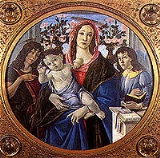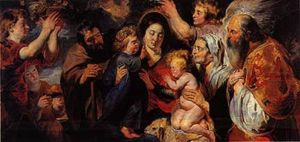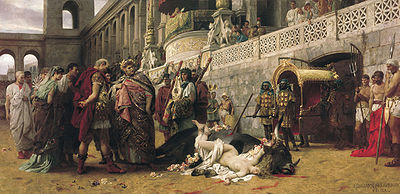
National Museum in Warsaw
Encyclopedia
The National Museum in Warsaw
, Poland
, is a national institution of culture, one of the largest museums in Poland and the largest in Warsaw. It comprise a rich collection of ancient art
(Egyptian
, Greek
, Roman
), counting about 11.000 pieces, an extensive gallery of Polish painting since the 16th century and a collection of foreign painting (Italian
, French
, Dutch
, German
and Russian
). The museum is also home to numismatic
collections and a gallery of applied art
s.
, and the Museum of Industry and Agriculture).
The collection is housed in the building at Jerusalem Avenues which was developed between 1927 and 1938 (earlier the museum had been located at ulica Podwale 15). In 1932 an exhibition of decorative art was opened in the two earlier erected wings of the building. A new building was inaugurated on 18 June 1938. From 1935 the museum director was Stanisław Lorentz.
During World War II
the building was damaged and the collection looted by German soldiers. After the war the Polish Government, under the supervision of Prof Lorentz, retrieved many of the works seized by the Germans. Still more than 5.000 artefacts are missing. At present, the collection of the National Museum in Warsaw includes over 780.000 items displayed in many permanent galleries, including the Professor Kazimierz Michałowski Faras Gallery and galleries given over to Ancient Art, Medieval Art, Foreign Painting, Polish Painting, European Goldsmithing, Oriental Art, Twentieth Century Polish Art, Polish Decorative Art and European Decorative Art, as well as many temporary exhibitions.
In 2008 the "Polish Archaeological Mission "Tyritake
" of National Museum in Warsaw" commenced works at Tyritake
, Crimea
. It is headed by Alfred Twardecki
curator of the Ancient Art Gallery.


Warsaw
Warsaw is the capital and largest city of Poland. It is located on the Vistula River, roughly from the Baltic Sea and from the Carpathian Mountains. Its population in 2010 was estimated at 1,716,855 residents with a greater metropolitan area of 2,631,902 residents, making Warsaw the 10th most...
, Poland
Poland
Poland , officially the Republic of Poland , is a country in Central Europe bordered by Germany to the west; the Czech Republic and Slovakia to the south; Ukraine, Belarus and Lithuania to the east; and the Baltic Sea and Kaliningrad Oblast, a Russian exclave, to the north...
, is a national institution of culture, one of the largest museums in Poland and the largest in Warsaw. It comprise a rich collection of ancient art
Ancient art
Arts of the ancient world refer to the many types of art that were in the cultures of ancient societies, such as those of ancient China, India, Mesopotamia, Persia, Egypt, Greece and Rome.-Egypt:...
(Egyptian
Art of Ancient Egypt
Ancient Egyptian art is the painting, sculpture, architecture and other arts produced by the civilization in the lower Nile Valley from 5000 BC to 300 AD. Ancient Egyptian art reached a high level in painting and sculpture, and was both highly stylized and symbolic...
, Greek
Art in Ancient Greece
The arts of ancient Greece have exercised an enormous influence on the culture of many countries all over the world, particularly in the areas of sculpture and architecture. In the West, the art of the Roman Empire was largely derived from Greek models...
, Roman
Roman art
Roman art has the visual arts made in Ancient Rome, and in the territories of the Roman Empire. Major forms of Roman art are architecture, painting, sculpture and mosaic work...
), counting about 11.000 pieces, an extensive gallery of Polish painting since the 16th century and a collection of foreign painting (Italian
Art of Italy
The history of Italian art is in many ways also the history of Western art. After Etruscan civilization and especially the Roman Republic and Empire that dominated this part of the world for many centuries, Italy was central to European art during the Renaissance. Italy also saw European artistic...
, French
French art
French art consists of the visual and plastic arts originating from the geographical area of France...
, Dutch
Dutch School (painting)
The Dutch School were painters in the Netherlands from the early Renaissance to the Baroque. It includes Early Netherlandish and Dutch Renaissance artists active in the northern Low Countries and, later, Dutch Golden Age painting in the United Provinces.Many painters, sculptors and architects of...
, German
German art
German art has a long and distinguished tradition in the visual arts, from the earliest known work of figurative art to its current output of contemporary art....
and Russian
Russian culture
Russian culture is associated with the country of Russia and, sometimes, specifically with ethnic Russians. It has a rich history and can boast a long tradition of excellence in every aspect of the arts, especially when it comes to literature and philosophy, classical music and ballet, architecture...
). The museum is also home to numismatic
Numismatics
Numismatics is the study or collection of currency, including coins, tokens, paper money, and related objects. While numismatists are often characterized as students or collectors of coins, the discipline also includes the broader study of money and other payment media used to resolve debts and the...
collections and a gallery of applied art
Applied art
Applied art is the application of design and aesthetics to objects of function and everyday use. Whereas fine arts serve as intellectual stimulation to the viewer or academic sensibilities, the applied arts incorporate design and creative ideals to objects of utility, such as a cup, magazine or...
s.
History
The National Museum in Warsaw was established on 20 May 1862, as the "Museum of Fine Arts, Warsaw", and in 1916 renamed "National Museum, Warsaw" (with the inclusion of collections from museums and cultural institutions such as the Society of Care for Relics of the Past, the Museum of Antiquity at Warsaw University, the Museum of the Society for Encouragement of the Fine ArtsZacheta
The Zachęta National Gallery of Art, short Zachęta, , is one of Poland's most notable institutions for contemporary art. Situated in the centre of Warsaw, the main aim of the gallery is to present and support primarily Polish contemporary art and artists...
, and the Museum of Industry and Agriculture).
The collection is housed in the building at Jerusalem Avenues which was developed between 1927 and 1938 (earlier the museum had been located at ulica Podwale 15). In 1932 an exhibition of decorative art was opened in the two earlier erected wings of the building. A new building was inaugurated on 18 June 1938. From 1935 the museum director was Stanisław Lorentz.
During World War II
World War II
World War II, or the Second World War , was a global conflict lasting from 1939 to 1945, involving most of the world's nations—including all of the great powers—eventually forming two opposing military alliances: the Allies and the Axis...
the building was damaged and the collection looted by German soldiers. After the war the Polish Government, under the supervision of Prof Lorentz, retrieved many of the works seized by the Germans. Still more than 5.000 artefacts are missing. At present, the collection of the National Museum in Warsaw includes over 780.000 items displayed in many permanent galleries, including the Professor Kazimierz Michałowski Faras Gallery and galleries given over to Ancient Art, Medieval Art, Foreign Painting, Polish Painting, European Goldsmithing, Oriental Art, Twentieth Century Polish Art, Polish Decorative Art and European Decorative Art, as well as many temporary exhibitions.
In 2008 the "Polish Archaeological Mission "Tyritake
Tyritake
Tyritáke was an ancient Greek town of the Bosporan Kingdom, situated in the eastern part of Crimea, about 11 km to the south from Panticapaeum. It is tentatively identified with the ruins in the Kerch district of Kamysh-Burun , on the shore of the Cimmerian Bosporus...
" of National Museum in Warsaw" commenced works at Tyritake
Tyritake
Tyritáke was an ancient Greek town of the Bosporan Kingdom, situated in the eastern part of Crimea, about 11 km to the south from Panticapaeum. It is tentatively identified with the ruins in the Kerch district of Kamysh-Burun , on the shore of the Cimmerian Bosporus...
, Crimea
Crimea
Crimea , or the Autonomous Republic of Crimea , is a sub-national unit, an autonomous republic, of Ukraine. It is located on the northern coast of the Black Sea, occupying a peninsula of the same name...
. It is headed by Alfred Twardecki
Alfred Twardecki
Alfred Twardecki is a Polish historian of antiquity and translator. He works as curator at the Department of Ancient Art in the National Museum in Warsaw...
curator of the Ancient Art Gallery.
Gallery of European Painting


- Sandro BotticelliSandro BotticelliAlessandro di Mariano di Vanni Filipepi, better known as Sandro Botticelli was an Italian painter of the Early Renaissance...
, The Virgin and Child, St. John and Angels, - Paris BordoneParis BordoneParis Bordon was an Italian painter of the Venetian Renaissance who, despite training with Titian, maintained a strand of mannerist complexity and provincial vigor.-Biography:...
, Venus and Cupid, - Hendrick ter BrugghenHendrick ter BrugghenHendrick Jansz ter Brugghen was a Dutch painter, and a leading member of the Dutch followers of Caravaggio — the so-called Dutch Caravaggisti.- Biography :...
, King David Playing Harp, - Philippe de ChampaignePhilippe de ChampaignePhilippe de Champaigne was a Flemish-born French Baroque era painter, a major exponent of the French school.-Early life:Born in Brussels of a poor family, Champaigne was a pupil of the landscape painter Jacques Fouquières...
, Portrait of Cardinal Richelieu, - Cima da ConeglianoCima da ConeglianoGiovanni Battista Cima, also called Cima da Conegliano was an Italian Renaissance painter.-Biography:Giovanni Battista Cima was born at Conegliano, now part of the province of Treviso, in 1459 or 1460...
, Christ among the Doctors, - Willem Claesz Heda, Still Life,
- Lucas Cranach the ElderLucas Cranach the ElderLucas Cranach the Elder , was a German Renaissance painter and printmaker in woodcut and engraving...
, Adam and Eve, - Jacques-Louis DavidJacques-Louis DavidJacques-Louis David was an influential French painter in the Neoclassical style, considered to be the preeminent painter of the era...
, Portrait of count Stanislas PotockiPortrait of Count Stanislas PotockiThe Portrait of Count Stanislas Potocki is a 1780 equestrian portrait of the Polish patron, politician and writer Stanisław Kostka Potocki by the French painter Jacques-Louis David...
, - Carel FabritiusCarel FabritiusCarel Fabritius was a Dutch painter and one of Rembrandt's most gifted pupils.-Biography:Fabritius was born in Beemster, the ten-year old polder, as the son of a schoolteacher. Initially he worked as a carpenter . In the early 1640s he studied at Rembrandt's studio in Amsterdam, along with his...
, The Raising of Lazarus, - Jean-Baptiste GreuzeJean-Baptiste GreuzeJean-Baptiste Greuze was a French painter.-Early life:He was born at Tournus, Saône-et-Loire. He is generally said to have formed his own talent; this is, however, true only in the most limited sense, for at an early age his inclinations, though thwarted by his father, were encouraged by a...
, Guitarist, - Jacob JordaensJacob JordaensJacob Jordaens was one of three Flemish Baroque painters, along with Peter Paul Rubens and Anthony van Dyck, to bring prestige to the Antwerp school of painting. Unlike those contemporaries he never traveled abroad to study Italian painting, and his career is marked by an indifference to their...
, The Holy Family with St. John, His Parents and Angels, - Jacopo Tintoretto, Portrait of an Admiral,
- Peter Paul Rubens (his studio), Virgin and Child,
- Rembrandt van Rijn, Portrait of Maerten Soolmans.
Gallery of Polish Painting
- Jan MatejkoJan MatejkoJan Matejko was a Polish painter known for paintings of notable historical Polish political and military events. His most famous works include oil on canvas paintings like Battle of Grunwald, paintings of numerous other battles and court scenes, and a gallery of Polish kings...
, Battle of GrunwaldBattle of GrunwaldThe Battle of Grunwald or 1st Battle of Tannenberg was fought on 15 July 1410, during the Polish–Lithuanian–Teutonic War. The alliance of the Kingdom of Poland and the Grand Duchy of Lithuania, led respectively by King Jogaila and Grand Duke Vytautas , decisively defeated the Teutonic Knights, led...
, - Józef MehofferJózef MehofferJózef Mehoffer was a Polish painter and decorative artist, one of the leading artists of the Young Poland movement and one of the most revered Polish artists of his time.-Life:...
, The Strange Garden, - Jacek MalczewskiJacek MalczewskiJacek Malczewski was one of the most famous painters of Polish Symbolism. In his creativity he successfully joins the predominant style of his times with motifs of Polish martyrdom.-See also:...
, Polish Hamlet, - Henryk SiemiradzkiHenryk SiemiradzkiHenryk Siemiradzki was a Polish 19th century painter active in the period of foreign Partitions of Poland, and best remembered for his monumental Academic art...
, Dirce, - Stanisław Wyspiański, Self-portrait.

